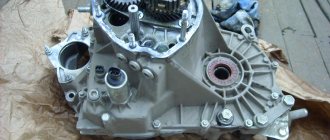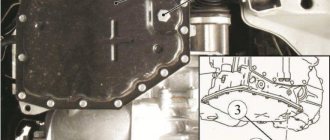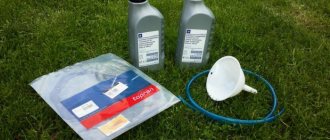How much oil is needed to change an automatic transmission depends not only on the capacity of the box. The replacement method also influences: partial, full or hardware with preemption. And here the age of the machine and the frequency of maintenance are already taken into account. The older the transmission, the more often consumables have to be changed. Purchasing original fluids or high-quality analogues will help reduce the frequency of ATF replacement and extend the life of the machine.
Is replacement necessary and after how long should it be changed?
In most cases, car manufacturers indicate that oil is poured into the gearbox for its entire service life. For this reason, many do not pay attention to the information about how many liters of oil are poured into the box. This question arises only with the need to carry out such an operation
WATCH THE VIDEO
When studying the routine operations of most modern cars during maintenance, control of the oil box is prescribed at intervals of 45-60 thousand km. Only in models of earlier years of production must a mandatory replacement of the automatic transmission fluid be made after a mileage of 90 or 120 thousand km, taking into account the manufacturer’s recommendations.
Despite this approach of car companies, service station workers recommend performing preventive replacement in the following cases:
- The appearance of leaks in the box body during a control inspection. Such monitoring is usually carried out at each maintenance - after 15 (10) thousand km.
- Violation of the normal operation of the gear parts in the gearbox. This manifests itself for a mechanical unit as noise during operation and difficulties when switching, and for an automatic unit as overheating, jerking when switching to another mode, or the inability to switch.
- Under difficult vehicle operating conditions.
Do not forget about the situation when it is necessary to change the oil in the gearbox after any repair involving disassembling the unit.
- Google+
- LJ
- Blogger
How often to fill the gearbox with oil
The lubricant protects the gearbox from wear.
The frequency of oil changes depends on which gearbox is installed in the vehicle. In addition, the load on the unit plays a big role.
The manual gearbox has a simple design. In it, torque is transmitted to the drive wheels through shafts and gears, which are constantly in contact with each other. If your car has a manual transmission, you need to change the oil at least every 150 thousand kilometers. Cargo transportation, movement over rough terrain, adverse weather conditions - such loads reduce the frequency of oil changes by half.
Automatic transmissions differ in their operating principles, but they are all uniquely more complex than mechanics. The oil in them is the working fluid. It not only lubricates the transmission parts, but also removes heat from the torque converter. For stable operation of the automatic transmission, it is recommended to change the oil in it every 30–50 thousand kilometers.
A CVT is a continuously variable transmission in which torque is transmitted from the engine to the transmission through 2 pulleys. Such a box is very sensitive to slipping, frequent acceleration and deceleration. Aggressive driving wears out pulleys and transmission belts, causing particles from moving parts to contaminate the oil. Therefore, experienced auto repairmen recommend changing the lubricant in CVTs after about 40 thousand kilometers.
A robotic gearbox with two clutches is essentially two manual gearboxes with an electronic control unit that automatically changes gears. In this case, one manual transmission is responsible for even speeds, the second for odd ones. In a manual transmission, many complex parts experience load: clutch discs, servo and hydraulic drives, valve body, etc. In order for a complex unit to serve without interruption, it is recommended to change the oil in it every 50-60 thousand kilometers.
These indicators are approximate - in any case, you should follow the recommendations established by the car manufacturer.
How to determine when it's time to change the oil:
- By mileage
- After purchasing a used car, unless there is reliable evidence of a recent replacement.
- There are jerks and delays when shifting gears
What to pay attention to when changing gearbox oil in order to prevent possible serious damage to the unit:
- used oil smells like burning;
- the amount of work is less than required;
- the used lubricating fluid has become very dark;
- Metal particles were found in the used oil.
But what happens if you ignore the recommendations for changing the gearbox oil? Over time, the lubricating fluid loses its original properties, becomes dirty, foams and thickens. Because of this, the gearbox components stop working as expected, which leads to gear shifting, increased friction losses and an increase in operating temperature. As a result, the gearbox quickly wears out, which can lead to extremely expensive repairs or complete replacement of the unit.
What is the volume of fluid in a manual transmission and automatic transmission?
The question of how much oil should be poured into the gearbox usually arises before the replacement itself. Such information is indicated in the maintenance manuals or car service book. Carefully study the “Refill Capacities” section.
If official information on how many liters of oil is needed in the box is not at hand, then you should pay attention to specialized services. Information resources have long been created on the Internet, where all refueling volumes for any model of the world's major automobile companies are collected.
Is it often necessary to fill the gearbox with oil in full?
If you need to add some oil to the gearbox, you will most likely have to purchase extra fluid. Usually the packaging has a volume of 1 liter, and the units contain a fractional volume fraction - 3.3 or 2.2 liters, for example.
- Google+
- LJ
- Blogger
To carry out partial filling of the composition into the box, a suitable method must be determined. Typically, oil is poured into the gearbox through the filler plug, and if there is none, use the dipstick hole.
Partial topping is carried out when a low fluid level in the housing is detected. In addition, partial replacement means such an operation for an automatic unit when it is carried out without opening the housing. This involves partially displacing the liquid by adding a new compound.
How to top up?
If, when checking the level, you find that the volume is close to or below 0, and it is not yet time to change the oil, then you need to top it up and find out the reason for its consumption or leakage. In many cars, the refilling process is quite simple. If the box is equipped with a filling plug, which, as a rule, is located on top and is easy to access, then you just need to unscrew it and add the required amount of liquid.
Filler plug in gearbox
If the gearbox does not have a plug, then you can add it through the dipstick hole. To do this, arm yourself with an ordinary large medical syringe, use it to draw up oil and inject it into the hole. In cars that do not have a dipstick or filler plug, it is necessary to add oil through the sensor holes. As a rule, this is a speed sensor or a reverse sensor. When topping up, the main thing is not to overdo it, since excess lubricant can lead to rapid failure of the gearbox.
How to check the level in an automatic and manual transmission
Depending on the type of unit, manufacturers provide several ways to control how much oil is currently in the gearbox:
- using an oil ruler;
- using the viewing window;
- using the filling hole.
Regardless of the method of controlling the amount of oil filled, you should place the car on a level surface. Several minutes should pass between stopping movement and taking the measurement until the lubricating fluid collects in the lower part of the unit.
If the liquid level is monitored, some volume may leak out through the filler plug. The level in this case is considered normal.
It will not be superfluous if the selected oil undergoes visual inspection to determine its condition.
- Google+
- LJ
- Blogger
Interchangeability of transmission oils
The automatic transmission of 90s cars was created in the late 80s, and no structural changes occurred until 2003. Therefore, new ATF cannot be poured into automatic transmissions of cars from the 90s.
There are certain nuances of replacing modern oils:
Dexron II can be replaced by Dexron III (but not vice versa) if the equipment allows for an increase in modifiers that can reduce friction. This group includes GM boxes.
In cases where the equipment cannot reduce the coefficient of friction by increasing the effectiveness of the additives, Dexron III cannot replace Dexron II.
Regardless of hardware, Dexron IIE replaces Dexron IID, but not vice versa. Replacement is often due to the fact that Dexron IID does not tolerate frost well - it is suitable for use at temperatures not lower than -15. It is worth considering that Dexron IIE is needed only in the northern regions and costs 2-3 times more.
Replacement procedure
Before starting the replacement, carefully study the procedure for carrying out operations, since the algorithm will differ depending on the type of box and the completeness of the composition replacement.
The upcoming gearbox oil change will require not only understanding the procedure for carrying out operations. Prepare all materials and tools in advance. You will definitely need:
- container for waste composition;
- set of tools;
- new oil in the required quantity;
- rags.
The owner of the automatic transmission must clarify in advance the presence of a filter element in the automatic unit. First, do not forget to check where the filler plug in the gearbox is located and clean it.
Choosing oil: not the best one that flows
When choosing the appropriate composition, keep in mind that not all oils are poured into the axles and gearbox indiscriminately. Operating experience of the first VAZ models suggests that the owner did no harm if he poured gearbox oil into the engine. Make sure what type of viscosity and base the manufacturer recommends. If semi-synthetic compounds were still used for the first generation Kia Rio, now only synthetic oils with a complex of additives are used.
- Google+
- LJ
- Blogger
To fill the automatic transmission, ATF class oil is used, which not only lubricates and cools the parts, but also transmits part of the torque. It is not necessary to use the original composition, but the analogue must have guaranteed quality.
Is it possible to mix ATF oils from different manufacturers?
When stirring, sediment may appear - white flakes that can clog the transmission. First of all, CVTs and automatic transmissions suffer from this. If the filters become clogged, the system will quickly fail. In some cases, no sludge will form, but the performance of the transmission is at stake.
Important! Mixing synthetics and mineral water will not result in semi-synthetics.
But a lot of foam is formed, which after 500 km thickens and forms precipitation. The oil seal may be squeezed out. If whitish flakes are detected, the system is completely flushed.
Examination
The oil level in a manual transmission is usually checked after the car has been idle overnight. The longer it sits with the engine turned off, the more accurate the results will be in order to understand when to change the oil in the gearbox.
To do this, wipe the crankcase where the speedometer drive is located. The bolt is turned out, the fasteners are removed, and then the assembly is removed. It is, of course, better to pour the bolt itself with Vedashka and be careful not to rip off the head.
The check is carried out by the speedometer drive gear. A slight excess of the level is acceptable. But there should be no shortage of it under any circumstances.
So, it was found that the oil volume in the VAZ-2114 gearbox is 3.5 liters. But, when replacing, a smaller volume will be filled in, since 200 grams of lubricating fluid remains inside the unit.
DIY oil change instructions
The oil change procedure is very simple and does not require special knowledge or tools. Any car owner can do it with his own hands. Before starting work, it is necessary to warm up the car and gearbox by driving at least 15–20 km.
We recommend: Types and types of gearboxes (gearboxes)
Required Tools
After warming up the box, you will need to prepare tools and consumables:
- an empty container with a capacity of at least 4 liters for draining used oil;
- key of any type with a size of 17 mm;
- rags;
- a funnel with a hose with a diameter of no more than 10-12 mm;
- canister with fresh oil.
Algorithm of actions
The procedure for changing the oil is as follows:
- Place the car on a horizontal pit or overpass.
- Remove the dipstick from the gearbox housing.
- If the engine and gearbox protection is installed below, it must be removed.
- Wipe the lower part of the crankcase with a rag and use a 17 mm wrench to unscrew the drain plug.
- Place the container and drain the oil. Complete draining of the oil takes at least 15 minutes.
- Wipe the plug and threads with a clean rag.
- Screw the plug in by hand and tighten it with a wrench.
- Install a hose with a funnel into the dipstick hole and fill in approximately 3.3 liters of fresh oil.
- Wait a few minutes for the oil to drain into the crankcase and check the level.
- If necessary, add oil or pump out excess.
- After 200-300 km, re-check the level and make sure there are no oil leaks through the drain plug or box seals.
Oil level dipstick on the top of the crankcase Drain plug on the bottom of the crankcase











